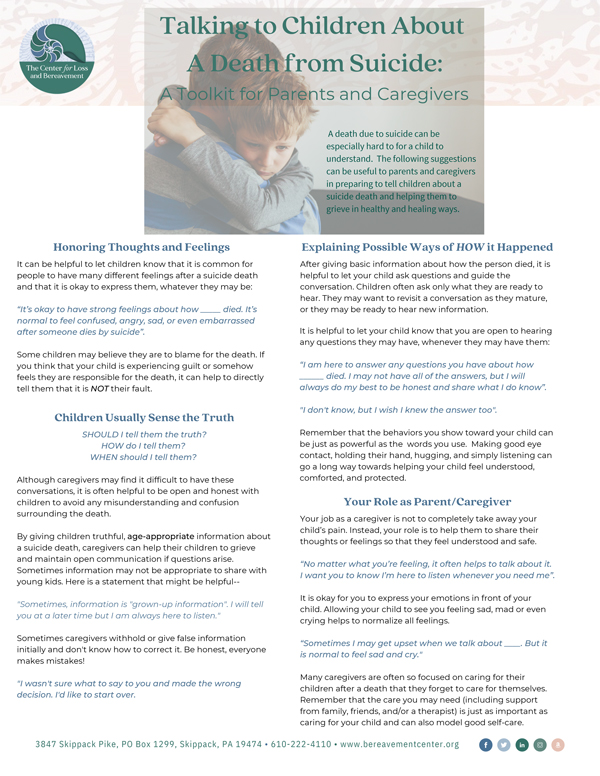CLB Tip Sheets
Talking to Children About a Death from Suicide: A Toolkit for Parents and Caregivers
A death due to suicide can be especially hard to for a child to understand. The following suggestions can be useful to parents and caregivers in preparing to tell children about a suicide death and helping them to grieve in healthy and healing ways.
Honoring Thoughts and Feelings
It can be helpful to let children know that it is common for people to have many different feelings after a suicide death and that it is okay to express them, whatever they may be:
“It’s okay to have strong feelings about how _____ died. It’s normal to feel confused, angry, sad, or even embarrassed after someone dies by suicide”.
Some children may believe they are to blame for the death. If you think that your child is experiencing guilt or somehow feels they are responsible for the death, it can help to directly tell them that it is NOT their fault.
Children Usually Sense the Truth
SHOULD I tell them the truth?
HOW do I tell them?
WHEN should I tell them?
Although caregivers may find it difficult to have these conversations, it is often helpful to be open and honest with children to avoid any misunderstanding and confusion surrounding the death.
By giving children truthful, age-appropriate information about a suicide death, caregivers can help their children to grieve and maintain open communication if questions arise. Sometimes information may not be appropriate to share with young kids. Here is a statement that might be helpful—
“Sometimes, information is “grown-up information”. I will tell you at a later time but I am always here to listen.”
Sometimes caregivers withhold or give false information initially and don’t know how to correct it. Be honest, everyone makes mistakes!
“I wasn’t sure what to say to you and made the wrong decision. I’d like to start over.
Explaining Possible Ways of HOW it Happened
After giving basic information about how the person died, it is helpful to let your child ask questions and guide the conversation. Children often ask only what they are ready to hear. They may want to revisit a conversation as they mature, or they may be ready to hear new information.
It is helpful to let your child know that you are open to hearing any questions they may have, whenever they may have them:
“I am here to answer any questions you have about how ______ died. I may not have all of the answers, but I will always do my best to be honest and share what I do know”.
“I don’t know, but I wish I knew the answer too”.
Remember that the behaviors you show toward your child can be just as powerful as the words you use. Making good eye contact, holding their hand, hugging, and simply listening can go a long way towards helping your child feel understood, comforted, and protected.
Your Role as Parent/Caregiver
Your job as a caregiver is not to completely take away your child’s pain. Instead, your role is to help them to share their thoughts or feelings so that they feel understood and safe.
“No matter what you’re feeling, it often helps to talk about it. I want you to know I’m here to listen whenever you need me”.
It is okay for you to express your emotions in front of your child. Allowing your child to see you feeling sad, mad or even crying helps to normalize all feelings.
“Sometimes I may get upset when we talk about ____. But it is normal to feel sad and cry.”
Many caregivers are often so focused on caring for their children after a death that they forget to care for themselves.
Remember that the care you may need (including support from family, friends, and/or a therapist) is just as important as caring for your child and can also model good self-care.
Explain Possible Reasons of WHY it Happened
When explaining a suicide death to children, it is helpful to use clear, simple language, while also considering their developmental stage (what they can understand) and their own individual grief reactions. There are many different reasons why a person may die by suicide, and it is often hard, and perhaps impossible at times, to know exactly why it happened. This uncertainty can make understanding and explaining the death much more difficult. You can begin the conversation by pointing out, if appropriate, that some people die by suicide because they suffer from a serious mental health problem:
“Some people struggle with serious mental health problems, like severe depression or sadness, that make it very hard for them to think clearly and make good decisions.”
You can also describe how mental illness can lead people to feel trapped, helpless, or hopeless:
“ ___ may have felt hopeless and wasn’t thinking clearly. ____ wasn’t able to think of other helpful choices or better ways of coping besides suicide.”
It can be helpful to let children know that people with serious mental health problems can get the help that they need it, through counseling or medication. Knowing this can help to ease a child’s worry.
It can also be comforting to let children know that they can’t “catch” a mental illness such as depression, the same way you catch a cold or a stomach virus:
“When someone in the family has a serious mental health problem and is not thinking clearly, it does not mean that other family members will have the same problem. Even though _____ died by suicide, it does not mean that other family members will too.”
How to Know if Your Child Needs Additional Help:
If you notice one or more of the following behaviors, your child may benefit from support from a trained grief therapist for individual counseling and/or from group support with children of their same age.
Wishing to be back with the person who died (“I keep hoping I might die so I can see ___ again”). Although common among bereaved children, these fantasies can lead to true suicidal thoughts or behaviors.
Having very frequent thoughts about death and dying, including the way in which the loved one died (“I can’t stop worrying that I’ll probably die the same way as ____ died”).
Talking about or mentioning a wish to die, or a wish to hurt oneself or others
Other high-risk behaviors to be watchful of include:
- Trouble keeping up with daily tasks (missing school and/or unable to finish assignments)
- Continuing to show signs of extreme sadness (including frequent crying, low energy, lack of desire to be with friends or family, appetite and sleep changes) for more than 6 months since the death occurred Risky or dangerous behavior (drug or alcohol use, reckless driving, stealing, etc.)
- Appearing numb or uninterested when talking about death and dying
National Suicide Prevention Lifeline: 988
Call or text 24 hours a day, English and Spanish
Join Our
Mailing List
Donate
Today
Request
Information

Affiliations
• NACG
• CBEM Changemaker
• ADEC
• Charity Navigator
Quick Links
About Us
Individual & Family Grief Counseling
Volunteer
News
Grief Support Resources
Contact
Ph: 610-222-4110
Fax: 610-222-4116
3847 Skippack Pike
P.O. Box 1299
Skippack, PA 19474
Support The Center For
Loss and Bereavement
